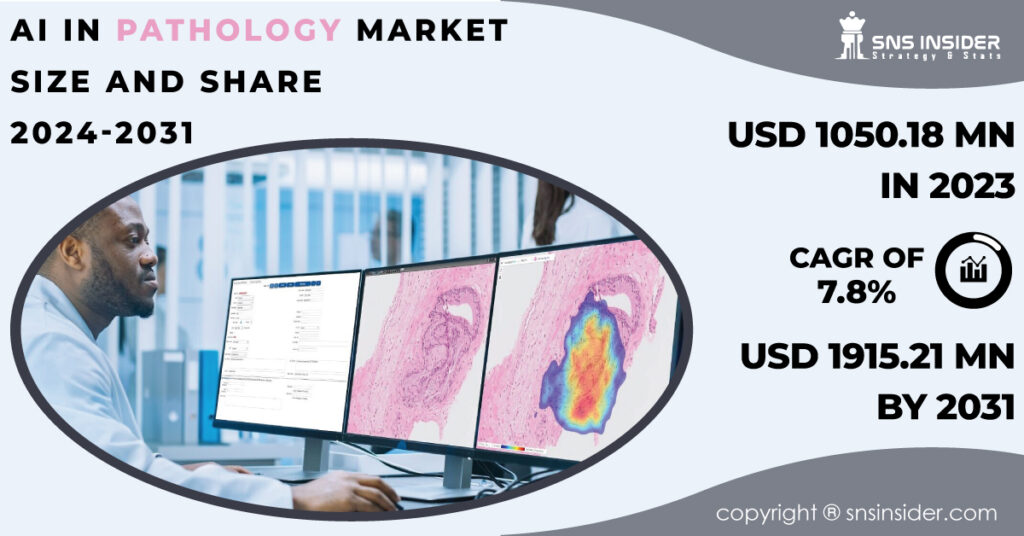
The global AI in pathology market is undergoing a transformative shift, poised for significant growth in the coming years. Traditionally, pathologists have relied on microscopes and their trained expertise to diagnose diseases by examining tissue samples. However, the integration of Artificial Intelligence (AI) is revolutionizing this field by offering unparalleled accuracy, efficiency, and objectivity in pathology workflows.
The AI in pathology market valuation will be reaching USD 1915.21 Million by 2031 and will grow at a CAGR of 7.8% over the forecast period of 2024-2031.

Download Free Sample Copy of AI in Pathology Market Report: https://www.snsinsider.com/sample-request/2844
Market Scope:
The market scope includes various components like AI-powered software solutions, digital pathology scanners that convert glass slides into digital images, and specific neural network architectures optimized for analysing these images. This technology finds application in diverse areas like cancer detection, personalized medicine, drug discovery, and streamlining routine diagnostic tasks.
List of AI in Pathology Companies Profiled in Report:
- Roche
- Leica Biosystems
- Hamamatsu Photonics
- Koninklijke Philips
- 3D Hsitech
- Apollo Enterprises Imaging
- Xifin
- Huron Digital Pathology
- Visionpharm
- Corista
- Indica Labs
- Objective Pathology Services
Opportunity analysis
The aging population, rising cancer incidences, and increasing healthcare expenditure globally are driving the demand for AI-powered pathology tools. Additionally, the growing adoption of digital pathology workflows creates a fertile ground for AI integration. Furthermore, AI’s ability to analyse vast amounts of data with unparalleled speed and accuracy offers immense potential for identifying subtle patterns and variations in tissue morphology, leading to earlier and more precise diagnoses.
Challenges:
The integration of AI into pathology holds immense promise, but faces hurdles before widespread adoption. A major challenge is the data requirement. Training AI models necessitates vast amounts of high-quality, annotated tissue samples. Fragmentation across healthcare systems and privacy regulations complicate data acquisition. Furthermore, a lack of standardization in pathology practices, where image capture and diagnostic protocols vary, can hinder the generalizability of AI algorithms. These factors contribute to a current market share of only around 2% for AI-powered pathology tools, according to industry estimates. Despite these challenges, the potential benefits of AI in streamlining workflows, reducing errors, and aiding pathologists in a field experiencing burnout are undeniable. As the technology matures and data hurdles are addressed, we can expect AI’s role in pathology to grow significantly.
AI in Pathology Market Segmentation:
By Neural Network Type
- Convolutional Neural Networks
- Recurrent Neural Networks
- Generative Adversarial Networks
- MVPNet
- Reinforced Auto Zoom Net
By Product Type
- Scanners
- Software
- Communication Systems
- Storage Systems
By Type
- Human Pathology
- Veterinary Pathology
By End User
- Pharmaceutical and Biotechnology Companies
- Hospitals and Reference Laboratories
- Academic and Research Institutes
By Application
- Teleconsultation
- Disease Diagnosis
- Drug Discovery
- Training and Education
Ask Your Query Before Buying this Research Report: https://www.snsinsider.com/enquiry/2844
Segmental Analysis:
The AI in pathology market provides to a diverse range of end users, each with distinct needs. Pharmaceutical & Biotechnology companies estimated 20% share in 2031 leverage AI for drug discovery, analysing vast datasets to identify potential treatments and optimize drug development. Hospitals & Reference Laboratories anticipated to hold the largest share at 35% by 2031 utilize AI for teleconsultation and improved diagnostics, enabling remote analysis and faster turnaround times. Academic & Research Institutes holds around 15% share in 2031 employ AI for training and education, developing new algorithms and supporting innovation in the field.
When it comes to applications, Disease Diagnosis is expected to hold the highest share of 25% by 2031 due to its crucial role in early detection and personalized medicine. Teleconsultation is also projected for significant growth, with AI facilitating remote consultations and improving access to pathology expertise for geographically dispersed patients
Regional Analysis:
North America currently dominates the market due to the strong presence of leading AI developers, high healthcare spending, and established digital pathology infrastructure. However, Asia Pacific is expected to witness the fastest growth rate fuelled by government initiatives promoting digital healthcare and a rapidly growing healthcare sector. Europe is another significant market with a supportive regulatory environment and a strong focus on personalized medicine.
Key Insights:
The impact of external factors like regulatory approvals and data privacy concerns cannot be ignored. Stringent regulations regarding AI-based medical devices can impede market growth. However, recent approvals by regulatory bodies like the FDA in the US for specific AI-powered pathology tools are encouraging signs. Data privacy is another crucial consideration, as AI algorithms rely on vast amounts of patient data. Robust data security protocols and adherence to ethical guidelines will be essential for building trust and ensuring widespread adoption.
Recent developments.
Leading companies like PaigeAI, InSignia Medical, and iPathology are continuously innovating and forging partnerships to develop and deploy cutting-edge AI solutions. For instance, PaigeAI partnered with Philips to integrate its AI algorithms into Philips’ digital pathology platform.
Buy AI in Pathology Market report: https://www.snsinsider.com/checkout/2844
Key Takeaways:
- The AI in pathology market presents a significant growth opportunity driven by rising healthcare needs and the increasing adoption of digital pathology.
- AI offers the potential for improved diagnostic accuracy, efficiency, and personalized medicine approaches.
- Regional variations exist, with North America leading currently, but Asia Pacific poised for rapid growth.
- Regulatory approvals, data privacy, and ongoing innovation by key players will significantly impact market development.
- The integration of AI in pathology holds the promise of a future with more precise diagnoses, improved patient outcomes, and a transformed healthcare landscape.
For more information and a comprehensive analysis of the AI in Pathology market, please refer to the full report available at https://www.snsinsider.com/reports/ai-in-pathology-market-2844
About US:
SNS Insider has been a leader in data and analytics globally with its authentic consumer and market insights. The trust of our clients and business partners has always been at the center of who we are as a company. We are a business that leads the industry in innovation, and to support the success of our clients, our highly skilled engineers, consultants, and data scientists have consistently pushed the limits of the industry with innovative methodology and measuring technologies.
We assist our clients to anticipate industrial, economic, and consumer trends to drive disruptive change by fusing global experience with local information from experts throughout the world. We bring context to strategic and tactical data by bridging approaches based on data science and field research, assisting you in addressing your most pressing problems and spotting possibilities.
Contact Us:
Akash Anand – Head of Business Development & Strategy,
Phone: +1-415-230-0044 (US) | +91-7798602273 (IND),
Website: https://www.snsinsider.com/
Information contained on this page is provided by an independent third-party content provider. Binary News Network and this Site make no warranties or representations in connection therewith. If you are affiliated with this page and would like it removed please contact [email protected]



Comments